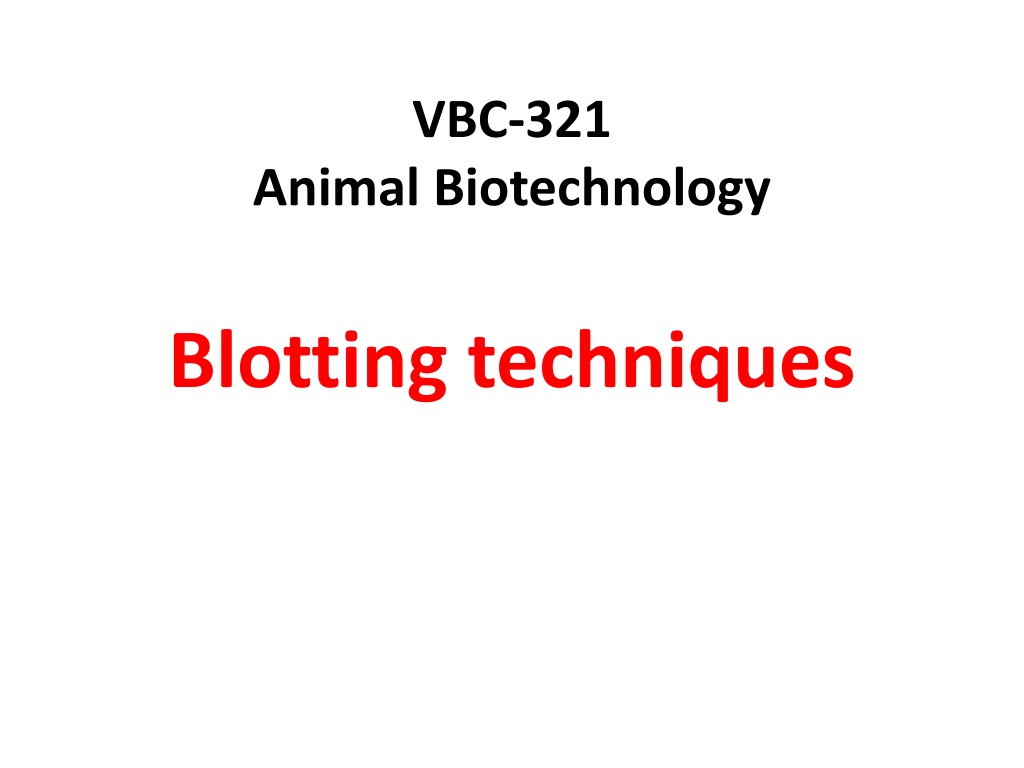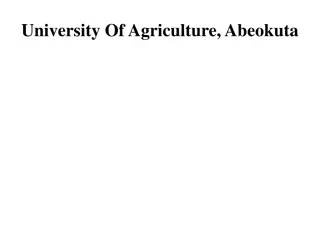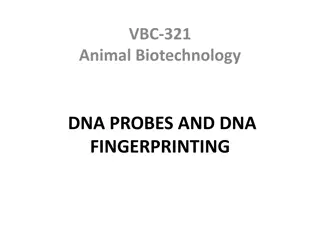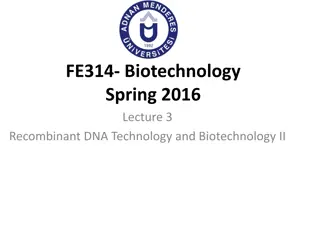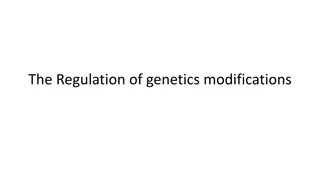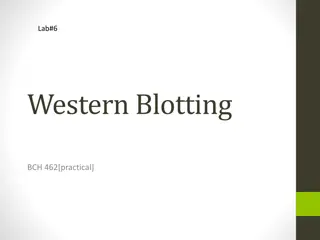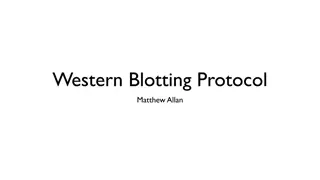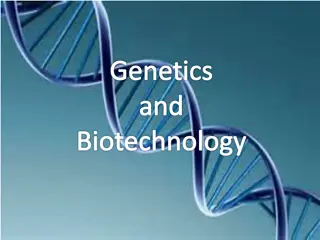Understanding Blotting Techniques in Animal Biotechnology
Blotting techniques such as Southern blot, Northern blot, and Western blot are used to transfer DNA, RNA, and proteins onto a carrier for separation following gel electrophoresis. Developed by E.M. Southern, the Southern blot specifically detects DNA fragments in a sample through hybridization. This method combines agarose gel electrophoresis with DNA transfer to a membrane for probe hybridization, allowing accurate identification of specific DNA sequences.
Download Presentation

Please find below an Image/Link to download the presentation.
The content on the website is provided AS IS for your information and personal use only. It may not be sold, licensed, or shared on other websites without obtaining consent from the author. Download presentation by click this link. If you encounter any issues during the download, it is possible that the publisher has removed the file from their server.
E N D
Presentation Transcript
VBC-321 Animal Biotechnology Blotting techniques
What is blotting? Blots are techniques for transferring DNA , RNA and proteins onto a carrier so they can be separated, and often follows the use of a gel electrophoresis. The Southern blot is used for transferring DNA, the Northern blot for RNA and the western blot for PROTEIN.
TYPES OF BLOTTING TECHNIQUES Blotting technique Southern Blot Northern Blot Western blot It is used to detect protein. It is used to detect DNA. It is used to detect RNA.
SOUTHERN BLOTTING The technique was developed by E.M. Southern in 1975. The Southern blot is used to detect the presence of a particular piece of DNA in a sample. The DNA detected can be a single gene, or it can be part of a larger piece of DNA such as a viral genome.
Cont. Southern blotting combines agarose gel electrophoresis for size separation of DNA with methods to transfer the size separated DNA to a filter membrane for probe hybridization. The key to this method is Hybridization. Hybridization - Process of forming a double-stranded DNA molecule between a single-stranded DNA probe and a single-stranded target patient DNA.
pcr_reagents PRINCIPLE 1. The mixture of molecules is separated. 2. The molecules are immobilized on a matrix. 3. The probe is added to the matrix to bind to the molecules. 4. Any unbound probes are then removed. 5. The place where the probe is connected corresponds to the location of the immobilized target molecule.
Steps in southern blotting 1. Digest the DNA with an appropriate restriction enzyme. 2.The complex mixture of fragments is subjected to gel electrophoresis to separate the fragments according to size.
Cont. 3.The restriction fragments present in the gel are denatured with alkali and transferred onto 4. a nitrocellulose filter or nylon membrane by blotting. This procedure preserves the distribution of the fragments in the gel, creating a replica of the gel on the filter.
Cont. 5.The filter is incubated under hybridization conditions with a specific radiolabeled DNA probe. The probe hybridizes to the complementary DNA restriction fragment.
Cont. 6.Excess probe is washed away and the probe bound to the filter is detected by autoradiography, which reveals the DNA fragment to which the probe hybridized.
SUMMARY OF PROCEDURE 1. Extract and purify DNA from cells 2. DNA is restricted with enzymes 3. Sort by electrophoresis 4. Denature DNA 5. Transfer to nitrocellulose paper 6. Block with excess DNA 7. Wash off unbound probe 8. Autoradiograph
APPLICATIONS Southern blots are used in gene discovery , mapping, evolution and development studies, diagnostics and forensics (It is used for DNA fingerprinting, preparation of RFLP maps) identification of the transferred genes in transgenic individuals, etc.
Northern Blotting Northern blotting is a technique for detection of specific RNA sequences. Northern blotting was developed by James Alwine and George Stark at Stanford University (1979) and was named such by analogy to Southern blotting
Steps involved in Northern blotting 1. RNA is isolated from several biological samples (e.g. various tissues, various developmental stages of same tissue etc.) * RNA is more susceptible to degradation than DNA.
Cont 2. Sample s are loaded on gel and the RNA samples are separated according to their size on an agarose gel . The resulting gel following after the electrophoresis run.
Cont 3 3. . The gel is then blotted on a nylon membrane or a nitrocellulose filter paper/ diazobenzyloxymethyl papers by creating the sandwich arrangement.
Cont 4 4. . The membrane is placed in a dish containing hybridization buffer with a labeled probe. Thus, it will hybridize to the RNA on the blot that corresponds to the sequence of interest. 5. The membrane is washed to remove unbound probe.
Cont 6 6. . The labeled probe is detected via autoradiography or via a chemiluminescence reaction (if a chemically labeled probe is used). In both cases this results in the formation of a dark band on an X-ray film. Now the expression patterns of the sequence of interest in the different samples can be compared. .
APPLICATIONS A standard for the study of gene expression at the level of mRNA(messenger RNA transcripts) Detection of mRNA transcript size Study RNA degradation Study RNA splicing Study RNA half-life Often used to confirm and check transgenic / knockout mice (animals)
Disadvantage of Nourthern plotting 1.The standard northern blot method is relatively less sensitive 2. Detection with multiple probes is a problem 3. If RNA samples are even slightly degraded by RNases, the quality of the data and quantitation of expression is quite negatively affected.
Western blotting Western blotting (1981) is an Immunoblotting technique which rely on the specificity of binding between a protein of interest and a probe (antibody raised against that particular protein) to allow detection of the protein of interest in a mixture of many other similar molecules. The SDS PAGE technique is a prerequisite for Western blotting .
Steps in western blotting A protein sample is subjected to 1. electrophoresis on an SDS- polyacrylamide gel. Electroblotting transfers the 2. separated proteins from the gel to the surface of a nitrocellulose membrane.
Cont 3. The blot is incubated with a generic protein (such as milk proteins or BSA) which binds to any remaining sticky places on the nitrocellulose. 4. An antibody that is specific for the protein of interest (the primary antibody - Ab1) is added to the nitrocellulose sheet and reacts with the antigen. Only the band containing the protein of interest binds the antibody, forming a layer of antibody molecules .
Cont 5. After washing for removal of non- specifically bound Ab1, second antibody (Ab2)is added, which specifically recognizes the Fc domain of the primary antibody and binds it. Ab2 is radioactively labeled, or is covalently linked to a reporter enzyme, which allows to visualize the protein-Ab1-Ab2 complex.
Application 1.The confirmatory HIV test 2.Western blot is also used as the definitive test for Bovine spongiform encephalopathy (BSE( 3.Some forms of Lyme disease testing employ Western blotting .
